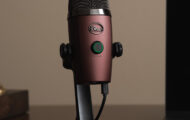
Laptops like the Toshiba Satellite Radius 12 could benefit from a 3.5mm digital-analogue audio output jack for an audio connection
Increasingly, there has been the rise of portable audio equipment associated with computers and there are opportunities to exploit what this all about for better sound.
Most of this equipment is implementing a 3.5mm tip-ring-sleeve phone socket for analogue line-level audio input or output connections. This is because the socket type is considered to be a “low-profile” connection that allows the equipment to be designed to be slim and neat. The same connector even appeals to the traditional PC expansion cards where the socket can easily exist on the card’s bracket.
Some devices, namely video projectors use the 3.5mm phone jack for this purpose, whether as an input or an output while this connector is also used as a so-called ad-hoc “walk-up” audio input or output connection on amplifiers or stereo systems such as an auxiliary input. This exploits the ability associated with the “phone” sockets where they can survive being connected and disconnected repeatedly thanks to their original use on the old telephone switchboards.
Sony took this connection type further during the MiniDisc era by equipping some of the CD Walkmans with a line-out jack that also had an LED in it and equipping their MiniDisc Walkman recorders with a mic/line input jack that had a photodiode in this socket. Then the user would connect a fibre-optic cable with 3.5mm fibre-optic connections on each end to provide a digital link between the CD Walkman and the MiniDisc Walkman to digitally copy a CD to MD with the sound transferred in the SP/DIF digital domain.

HDMI-equipped projectors could even exploit the 3.5mm digital-analogue output connection for use with sound systems that have a digital input
You would still be able to connect the portable device to a normally-sessile device like a digital amplifier by using an adaptor cable which had a Toslink plug on one end and a 3.5mm fibre-optic connection on the other end or use a Toslink-3.5mm adaptor with an existing Toslink fibre-optic cable.
A few other companies exploited this connection beyond the portable realm with Pace implementing it as a digital audio output on some of the cable-TV / satellite-TV set-top boxes. The set-top application implemented this connection just for the digital-audio application while the analogue audio connection was facilitated through the multiple-pin SCART connection.
This same single-socket connection could be easily implemented for a video projector that uses an HDMI input and a 3.5mm audio-output jack so you could have a digital connection to a sound system rather than an analogue audio link. This can also apply to laptop computers which are increasingly being purposed as party jukeboxes by younger people along with “mini-DJ” accessories pitched at iPod/iPhone users who want to play DJ.
Conversely, TVs and stereo systems could implement the same digital/analogue input for the auxiliary-input connection that is reserved on a TV for computer equipment or on the front of a stereo system for “walk-up” connection of portable digital-audio players.
But lately, Creative Technology, well-known for their Sound Blaster sound cards since the dawn of DOS/Windows multimedia computing in the 1990s, have implemented this approach for their Sound Blaster X G3, G5 and G6 USB external sound modules. These games-focused sound modules use the 3.5mm analogue/optical jack for their line-level inputs and outputs, thanks to recent games consoles and home-theatre equipment having SPDIF optical connections.
As far as equipment design is concerned, the single socket for a SPDIF-optical-digital or analogue audio connection saves on designing and budgeting for two sockets if you want to facilitate both a digital and an analogue audio connection. This is more important if the goal is to design equipment that has a low profile or is highly portable. The same approach can also appeal to providing for an ad-hoc digital/analogue input or output where the connection exists on an “as-needed” basis rather than a permanent basis.
Personally, I would like to see the 3.5mm digital-analogue audio jack that Sony valued during MiniDisc’s reign as something that can work with portable computing equipment, video projectors, smartphones and the like for transmitting audio in the SPDIF digital domain.
Update:
I have revised this article on 5 July 2020 due to subsequent research about Creative Labs Sound Blaster X G series USB sound modules with most of that product range making use of the 3.5mm analogue/optical phone socket for their line-level connections.



